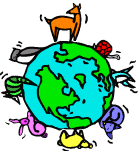The term ‘biosphere’ is used to describe the whole sum of living things found on Earth. Usually we think of the biosphere as existing within upper layers of the non-biotic components of the planet, namely the atmosphere, hydrosphere (oceans, rivers and lakes), and soil component of the lithosphere (the Earth’s solid material). In fact, research suggests that more biological mass resides within the Earth’s crust than in all the rest of the biosphere as described, largely consisting of bacteria and other single-celled organisms living within tiny spaces between rock minerals. Furthermore, some scientists and environmentalists speak of Earth or Gaia as a living organism in itself, engaged in a self-regulation to support its own survival. Although many have cast doubt on the merit of such an idea beyond a metaphorical application given the lack of substantial scientific evidence to support it, such a concept does reinforce the view inherent throughout sustainable development that all parts of the biosphere are interdependent, belonging as they do to a web of life.
The biosphere is composed of many ecosystems. An ecosystem consists of a community of living organisms and their local physical environment. The living and non-living elements of an ecosystem are connected through flows of energy and the cycling of chemical elements. In this context, no part of the biosphere that is smaller than an ecosystem can sustain life.
Imagine placing a single green plant in a glass jar with air, water, soil, and light from the sun. The plant could make its own food through photosynthesis (from water, carbon dioxide, and light). But eventually the plant would die as it used up all of the nutrients in the soil. It would die because it couldn’t recycle the materials it needs to live; no green plant can decompose its own products into the inorganic compounds necessary for plant life. In fact, no single organism, population, or species is able to produce all of its own food and recycle all of its metabolic products. Life requires the interaction of several species in an environment that includes air and/or water to transport materials and energy. This is one of the fundamental principles of ecology; sustained life is a property of ecosystems, not organisms or species.
A forest is a common ecosystem. Forests consist of air, soil, water, nutrients, and particular species of animals, birds, insects, micro-organisms, trees, and other plant life. If too many of the trees are cut down (for example by mankind for wood or agricultural land), each of the other elements will be affected. Animals and birds may lose their habitats, soil may erode, nutrients may be displaced, and the flow of waterways may change.
There are no absolute boundaries between ecosystems – really, the biosphere is one big ecosystem in which everything is connected to everything else in some way or another. Some ecosystem borders are, however, quite well defined. For example, there is a relatively clear transition from a rocky ocean coast to the forest along its edge, or from a pond to the wood that surrounds it. Other borders are much more vague, as is the case with the gradual transition from deciduous woodland to coniferous forests in some parts of the world.
Ecosystems change continuously over time according to certain recognisable, repeatable patterns, and in response to environmental changed such as shifts in climate. This is referred to as ‘succession’.
- Working from Home - March 21, 2024
- Eco-Friendly Companies in the UK - March 6, 2024
- Public Transport - February 15, 2020
